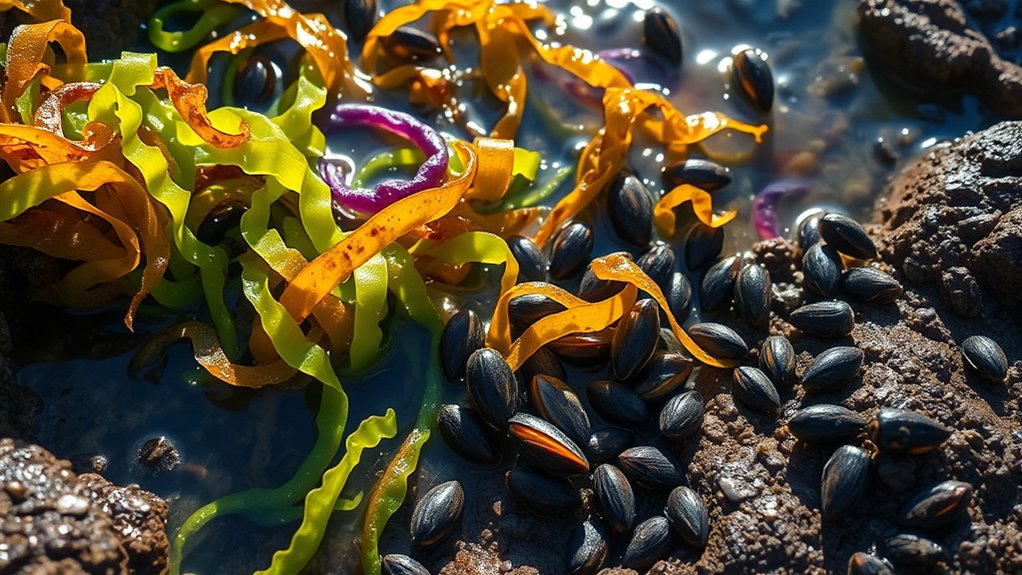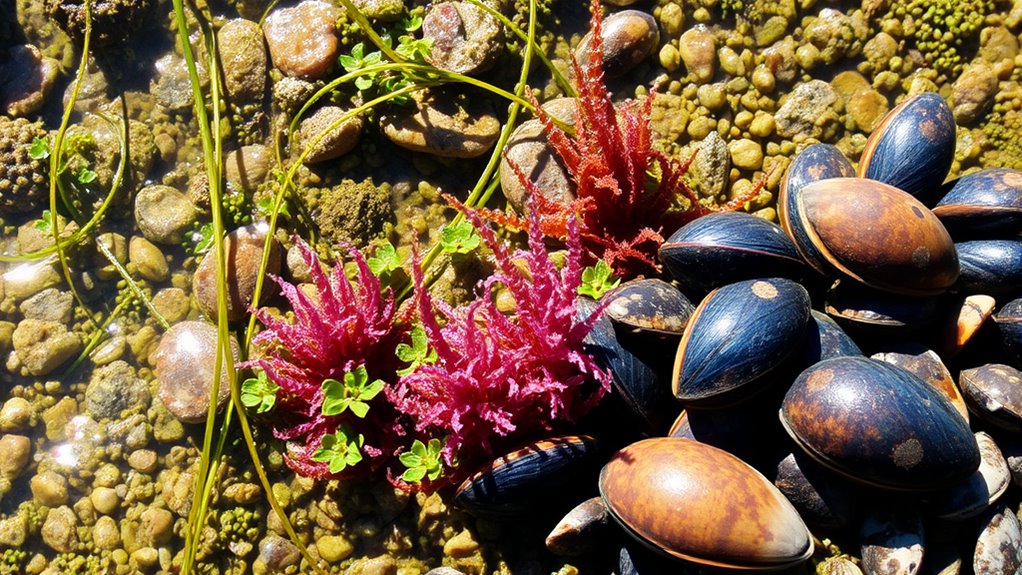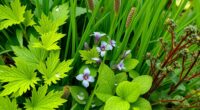When pairing wild sea vegetables with local shellfish, focus on how the coastal environment influences their flavors. Kelp adds a briny, umami touch that enhances shellfish’s natural sweetness and minerality. Each location’s unique tide-pool conditions lend a distinctive character, creating true terroir. By understanding these local influences, you can craft dishes that celebrate the land and sea. To explore how these elements unite in flavor, stay with us for more insights.
Key Takeaways
- Coastal environments shape the flavor profiles of sea vegetables and shellfish, reflecting unique terroir qualities.
- Harvested kelp adds umami, sweetness, and texture that complement the natural flavors of local shellfish.
- Pairing wild sea vegetables with shellfish highlights regional mineral notes and oceanic saltiness.
- Environmental factors like salinity, temperature, and sunlight influence the taste and pairing potential of local marine ingredients.
- Culinary combinations celebrate shoreline terroir, emphasizing the land-sea connection and local environmental authenticity.

When you explore tide pools along the coast, you’ll quickly notice that each one offers a unique sense of place, shaped by its specific environment. The way the water interacts with rocky outcroppings, the amount of sunlight filtering through, and the surrounding marine life all influence the flavors you encounter. One of the most intriguing aspects of tide-pool exploration is kelp foraging. As you wade through the shallow waters, you might spot kelp swaying beneath the surface, a crucial ingredient in creating a true coastal flavor profile. These seaweeds don’t just add texture and nutrition; they embody the essence of the shoreline, infusing dishes with the briny, umami-rich notes that define maritime cuisine.
Exploring tide pools reveals unique coastal flavors shaped by marine life and kelp foraging.
Kelp, with its robust, slightly sweet taste, serves as a cornerstone for pairing wild sea vegetables with local shellfish flavors. When you harvest kelp, you’re tapping into a flavor that’s been shaped by the specific environmental conditions of the coast—salinity, temperature, and nutrient flow. These elements influence the kelp’s taste, making each batch distinct. Incorporating freshly foraged kelp into your cooking enhances the natural marine flavors, creating a harmonious balance with local shellfish like clams, mussels, or oysters. The result is a culinary experience that captures the essence of the coast, where land meets sea in every bite.
The coastal flavor profiles you encounter are a reflection of this environment. Saltiness from the ocean, mineral notes from rocky substrates, and subtle sweetness from the kelp all come together, amplifying the taste of freshly harvested shellfish. When you pair wild sea vegetables with shellfish, you’re not just combining ingredients; you’re celebrating the terroir—the unique character of the coast that influences every flavor. This approach elevates simple seafood dishes into a tasting journey that highlights the region’s natural bounty.
As you experiment with pairing, pay attention to how the different coastal elements influence flavor. The more you immerse yourself in foraging and tasting, the more you’ll understand how to craft dishes that speak of their origin. Whether you’re preparing a kelp salad to accompany steamed mussels or using kelp broth to enhance a seafood stew, you’re actively blending the environment’s flavors into your culinary creations. Recognizing the specific environmental conditions that shape the taste of your ingredients can deepen your appreciation for the local terroir and improve your pairing skills. In doing so, you honor the land and sea, creating a true tide-pool terroir that celebrates the authentic taste of your coastal surroundings.
Frequently Asked Questions
How Do Tide Pools Influence Regional Flavor Profiles?
Tide pools influence regional flavor profiles by showcasing their unique biodiversity, which shapes local ingredients’ tastes. When you explore tide pools, you notice the diverse sea veggies and shellfish that thrive there, contributing distinct flavors to regional dishes. This biodiversity drives regional flavor development, as chefs and foragers incorporate these fresh, local ingredients. Consequently, tide pools become a crucial source for creating authentic, location-specific culinary experiences.
What Are the Best Seasonal Wild Sea Vegetables?
Did you know that wild sea vegetables like nori and wakame grow abundantly during the spring and fall? These seasons offer the best flavor and freshness, making foraging safer and more sustainable. To guarantee seaweed preservation, always harvest responsibly, avoiding over-collecting, and follow foraging safety tips. Picking at peak season guarantees the tastiest, most nutritious greens, enriching your dishes with vibrant, oceanic flavors.
How Can I Sustainably Harvest Sea Veggies?
To sustainably harvest sea veggies, you should follow local harvesting regulations to protect ecosystems. Use eco-friendly aquaculture techniques, like hand harvesting or selective cutting, to avoid damaging the plants or environment. Always check for seasonal restrictions and avoid overharvesting. Respect marine habitats, and consider harvesting from areas that practice sustainable aquaculture, ensuring future generations can enjoy these vibrant ocean greens while maintaining ecological balance.
Which Local Shellfish Pair Best With Specific Sea Vegetables?
You might think pairing shellfish with sea vegetables is obvious, but the irony is, some combinations surprise you. For example, clams complement salty, briny seaweed fermentation like kombu, enhancing umami. Mussels bring a sweet, mellow flavor that balances the oceanic sharpness of arame. Understanding shellfish flavor profiles helps you craft perfect pairings, making every bite a harmonious blend of local flavors and boosting your culinary adventure.
Are There Health Benefits to Combining Sea Veggies and Shellfish?
You’ll find that combining sea veggies and shellfish offers notable health benefits. This pairing creates a nutritional synergy, boosting your intake of essential minerals like iodine, zinc, and calcium. It also enhances immune-boosting properties, helping your body fight off illnesses naturally. Eating these together supports overall health, improves digestion, and promotes energy. So, enjoy this delicious, nutrient-rich combo for a stronger immune system and better well-being.
Conclusion
As you explore this coastal world, you realize the true magic lies in how these flavors intertwine. Each bite reveals a story waiting to unfold, a secret of the tide pools just beneath your feet. Will you discover the perfect pairing that captures this elusive essence? The ocean’s bounty holds more mysteries than you can imagine, inviting you to dive deeper. Are you ready to unveil the tide’s hidden treasures and savor its unforgettable terroir?










